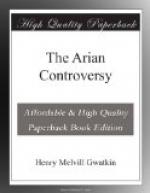the reach of the officials. This was the time
when the ascetic spirit, which had long been hovering
round the outskirts of Christianity, began to assume
the form of monasticism. There were monks in
Egypt—monks of Serapis—before
Christianity existed, and there may have been Christian
monks by the end of the third century. In any
case, they make little show in history before the reign
of Valens. Paul of Thebes, Hilarion of Gaza, and
even the great Antony are only characters in the novels
of the day. Now, however, there was in the East
a real movement towards monasticism. All parties
favoured it. The Semiarians were busy inside
Mount Taurus; and though Acacians and Anomoeans held
more aloof, they could not escape an influence which
even Julian felt. But the Nicene party was the
home of the ascetics. In an age of indecision
and frivolity like the Nicene, the most earnest striving
after Christian purity will often degenerate into its
ascetic caricature. Through the selfish cowardice
of the monastic life we often see the loving sympathy
of Christian self-denial. Thus there was an element
of true Christian zeal in the enthusiasm of the Eastern
Churches; and thus it was that the rising spirit of
asceticism naturally attached itself to the Nicene
faith as the strongest moral power in Christendom.
It was a protest against the whole framework of society
in that age, and therefore the alliance was cemented
by a common enmity to the Arian Empire. It helped
much to conquer Arianism, but it left a lasting evil
in the lowering of the Christian standard. Henceforth
the victory of faith was not to overcome the world,
but to flee from it. Even heathen immorality
was hardly more ruinous than the unclean ascetic spirit
which defames God’s holy ordinance as a form
of sin which a too indulgent Lord will overlook.
[Sidenote: New questions in controversy.]
Valens was only a catechumen, and had no policy to
declare for the present. Events therefore continued
to develop naturally. The Homoean bishops retained
their sees, but their influence was fast declining.
The Anomoeans were forming a schism on one side, the
Nicenes recovering power on the other. Unwilling
signatures to the Homoean creed were revoked in all
directions. Some even of its authors declared
for Arianism with Euzoius, while others drew nearer
to the Nicene faith like Acacius. On all sides
the simpler doctrines were driving out the compromises.
It was time for the Semiarians to bestir themselves
if they meant to remain a majority in the East.
The Nicenes seemed daily to gain ground. Lucifer
had compromised them in one direction, Apollinarius
in another, and even Marcellus had never been frankly
disavowed; yet the Nicene cause advanced. A new
question, however, was beginning to come forward.
Hitherto the dispute had been on the person of the
Lord, while that of the Holy Spirit was quite in the
background. Significant as is the tone of Scripture,
the proof is not on the surface. The divinity




